9 Top Financial Services Marketing Trends, Ideas, and Tips
- Home
- Intelligent Insights Blog
- 9 Top Financial Services Marketing Trends, Ideas, and Tips
If you operate a financial services business, you likely understand the importance of marketing.
However, it’s difficult to build and maintain trust amid changing consumer preferences.
Additionally, finding innovative ways to communicate the benefits and features of your services can seem counterintuitive.
So, how do you stay ahead of the curve in such a competitive and highly regulated industry?
The answer lies in keeping an ear to the ground on the latest financial services marketing trends.
As new technologies and marketing ideas emerge, outdated methods lose their effectiveness. That’s why it’s critical to be adaptive and open to refining your marketing strategies.
To make things easier for you, we’ve compiled 9 of the top financial services marketing trends and ideas for 2024.
Adopting these ideas is a great way to connect with consumers, retain existing clients, and improve the overall customer experience.
Read on to find out which trends and ideas are most relevant in 2024 and how to leverage them.
Want help refreshing your financial services PR and marketing strategy?
Let us help! Simply book a free consultation with one of our PR and marketing experts. We will take a look at your current strategy to see where it could benefit from a boost.
Our 9 Top Financial Services Marketing Trends
- Public Relations
- Thought Leadership
- Omnichannel Marketing
- Multi-Channel Marketing
- AI and Machine Learning
- Seasonal Content Marketing
- Conversational Messaging
- Personalization
- Digital Experience
1. Public Relations Can Build Trust Around Your Financial Services Brand
There’s a reason why public relations (PR) is one of the top financial services marketing trends.
First of all, it’s key to managing your financial institution’s image and reputation. It’s also critical for communication with the public, clients, and stakeholders.
Public relations helps you build trust and credibility in the financial industry. Plus, it facilitates meaningful engagement with customers, investors, and regulatory bodies. When a crisis occurs, PR allows you to mitigate reputation damage.
When leveraging PR, create compelling narratives that highlight the unique aspects of your financial services. This can include innovative solutions and client success stories. These stories should resonate with your target audience and align with your brand’s values.
Given the regulated nature of financial services, ensure your PR efforts adhere to all legal and compliance requirements. Be transparent and honest in your communication. This will help you build trust with your clients and the public.
This press release from Lumen is an example of how financial services companies use PR:

Pro Tip: PR doesn’t end with a press release. You’ll want to build long-lasting relationships and engage with relevant journalists and media outlets. You’ll also want to consider participating in industry conferences and webinars to showcase your knowledge and credibility.
Want to see the top PR trends for 2024 to better craft your strategy? Check out our article: 18 Top PR Trends Shaping the Industry in 2024
2. Thought Leadership Demonstrates Your Financial Services Expertise
Want to become a trusted source of information and guidance in the financial industry? Thought leadership is one of the best financial services marketing trends for building credibility.
Establishing thought leadership positions your financial brand as an industry authority. It attracts clients seeking expert guidance and increases client acquisition and retention.
Thought leadership requires a deep understanding of current financial trends and regulatory changes. Regularly update your knowledge of the financial industry. Showcase your expertise by discussing how new developments impact clients and offer innovative solutions.
Also, create a consistent and engaging content strategy. Use blogs, articles, webinars, or podcasts to share your insights and opinions.
This Forbes article provides an example of what thought leadership looks like in the financial services industry:
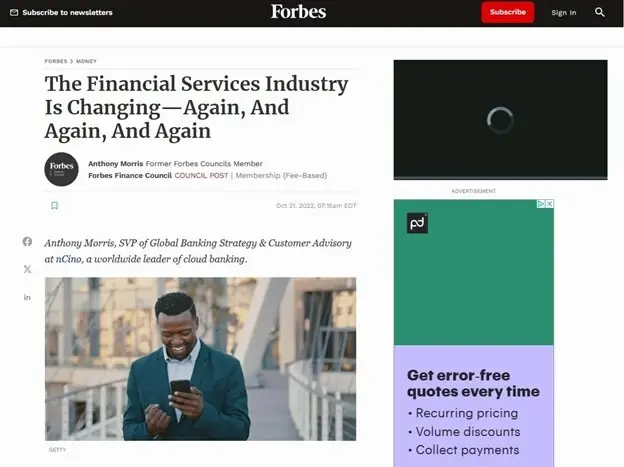
Pro Tips: Back up your thought leadership with data, research, and real-world examples. Use case studies to demonstrate the effectiveness of your strategies. This provides tangible evidence of your financial expertise.
Ready to get started on a cutting-edge thought leadership strategy? Not sure where to start? Then you’ll want to check out our article: Thought Leadership Strategy: 14 Steps to Balancing Authority and Authenticity (+ Examples)
3. Omnichannel Marketing Provides a Well-Rounded Customer Experience
Customer touchpoints don’t just include infrequent, large-scale interactions. Today, they include smaller engagements across various channels, including social media, apps, and SMS.
Banks and other financial services institutions are adapting by leveraging omnichannel strategies to enhance consumer engagement, foster trust, and boost loyalty. That’s what makes omnichannel marketing one of the emerging financial services marketing trends.
Omnichannel marketing is about providing customers with a consistent and seamless experience across various channels. Plus, it allows for the integration of customer data from different touchpoints. This enables better targeting and personalization.
When using omnichannel marketing, gather customer data from different channels to provide personalized and relevant content and services across all channels. Use built-in analytics to understand customer behavior and preferences.
Ensure a consistent and seamless experience as customers move between channels. Integrate data and communication to make transitions smooth. This helps customers feel like they are interacting with a single, unified entity rather than disjointed channels.
Still not convinced that omnichannel marketing is one of the top financial services marketing trends? Below, we’ve provided an example from Citi. You’ll notice that the website offers online banking options, as well as an ATM/branch locator in the top right corner:

Plus, you can download the Citi app on your smartphone:
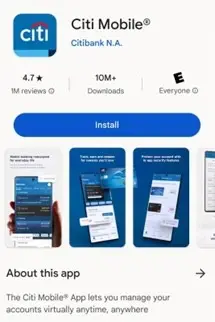
Citi’s experience allows customers to have a seamless experience online, offline, and on the go.
Pro Tip: Prioritize compliance and data security when using omnichannel marketing. Ensure that all channels meet regulatory requirements and implement robust security measures. This helps protect customer information and foster confidence in the safety of their data.
Interested in how to leverage mobile as one of your channels? Then you’ll want to stay up on mobile trends: 8 Mobile Marketing Trends to Upgrade Your Strategy in 2024
4. Multi-Channel Marketing Allows You to Use All Digital Platforms
Like omnichannel marketing, multi-channel is gaining traction as one of the leading financial services marketing trends. However, these two strategies are different.
Omnichannel marketing attempts to coordinate customer interactions online and offline seamlessly. Multi-channel marketing simply involves using various channels to reach customers. These channels may operate in silos, placing less focus on integration and consistency.
For example, multi-channel marketing can involve capturing user emails on one channel to deliver a variety of email marketing campaigns. This helps drive engagement and conversions.
Why do financial services brands use multi-channel marketing?
It allows you to reach diverse audiences through different channels. Plus, it provides flexibility in adapting to changing market conditions and customer preferences.
When using multi-channel marketing, understand your audience’s preferences and behavior. This helps you deliver content and offers that resonate with them. Use analytics to continuously optimize your multi-channel strategy based on what works best.
Also, ensure that all your multi-channel efforts comply with industry-specific laws and protect sensitive customer information.
Here are a few multi-channel marketing examples from Citi, starting with email subscriptions:
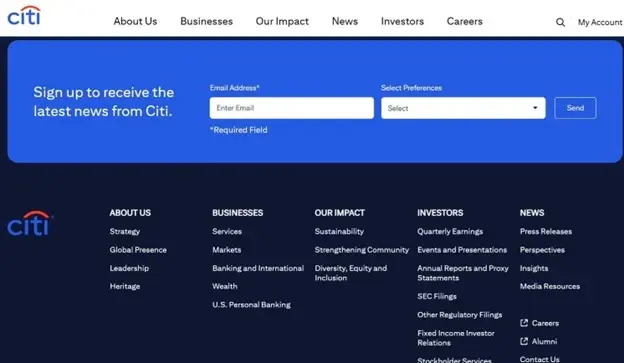
Here is Citi’s Facebook channel:

Here is Citi’s YouTube channel:

Pro Tip: Maintain a unified brand identity across all channels. While you don’t have to provide a seamless experience, ensure that your audience receives a cohesive and recognizable experience. This should apply to your website, mobile app, social media, or email messaging.
Want to learn more about how to best use email marketing in 2024? Then you’ll want to check out the current trends: 8 Email Marketing Trends and Best Practices for 2024 [+ Tips]
5. AI and Machine Learning is Streamlining the Marketing Process
Artificial intelligence (AI) and machine learning are among the top financial services marketing trends because they help reduce time and costs for financial services companies.
More specifically, AI and machine learning have become the driving force behind predictive analytics. They analyze vast datasets and provide actionable insights for decision-making.
This helps you reshape your marketing efforts to tailor products and services based on customer behavior and preferences.
Plus, AI automates many routine tasks. These include fraud detection, chatbots, virtual assistants, sentiment analysis, marketing automation, and much more.
To leverage AI and machine learning, use it to analyze customer data and behavior. This will help you deliver personalized marketing messages, product recommendations, and content.
Implement AI algorithms for real-time fraud detection and prevention. These systems can identify unusual transactions or behaviors. Plus, they can enhance security and trust in your financial services.
To get an idea of how AI is used in finance, see the video below:
Pro Tip: Use machine learning to forecast market trends, customer preferences, and potential financial risks. This proactive approach helps in making data-informed decisions. You can use this method to stay ahead in the competitive financial market.
More interested in automation? Here’s a full list of the top marketing automation trends for 2024: 10 Emerging Marketing Automation Trends for 2024
6. Financial Services Companies Are Focusing on Seasonal Content Marketing
Why is seasonal content one of the most important financial services marketing trends? It keeps your marketing efforts current and relevant.
Google’s research reveals seasonal patterns of increased engagement with financial products throughout the year. This suggests that people show varying levels of interest in specific offers at different times.
Financial services marketers should align content with trending topics in their target markets. Timely seasonal content can boost customer engagement, capitalizing on holiday or event-related promotions.
Plus, seasonal marketing encourages customer action. This includes holiday spending, investment opportunities, or tax planning.
When leveraging this strategy, stay updated on financial trends during specific seasons. For example, pay attention to stock market fluctuations or consumer spending patterns. Incorporate these trends into your content to stay current and address the topics that matter most.
Create a content calendar that aligns with financial seasons. This can be tax season or holiday spending. Be sure to prepare relevant, timely content in advance. Ensure that it’s well-researched and targeted.
The example below from Google’s report demonstrates how you should prioritize seasonal content in financial services marketing:
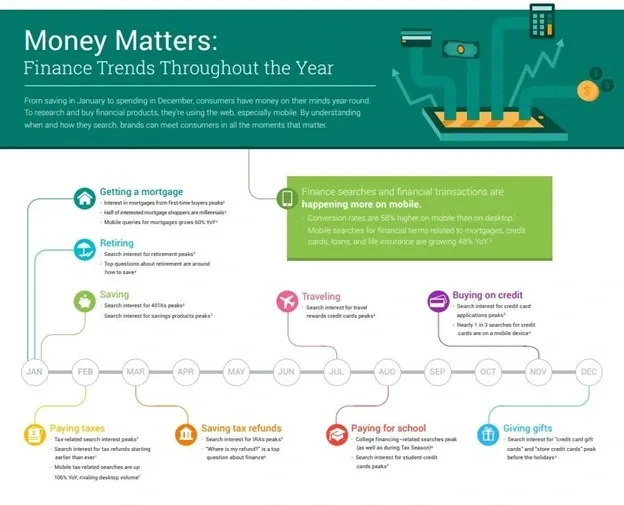
Pro Tip: Use seasonal content as an opportunity to educate your audience. For example, during tax season, provide guidance on tax planning or investment strategies.
Want to see how you can use other content marketing strategies to engage with your audience? Check out our guide: 7 Top Content Marketing Trends 2024 [+ Tips and Tricks]
7. Conversational Messaging Creates Provides Quick and Convenient Customer Support
Conversational messaging facilitates strong brand-consumer interaction, making it one of the leading financial services marketing trends. It typically includes chat, messaging, voice assistance, and natural language interfaces.
Conversational messaging uses natural language to engage customers throughout their buying journey. It provides them with personalized assistance and recommendations. It’s vital for online platforms to compete with in-store experiences by offering instant customer support.
Plus, it enhances customer satisfaction through quick, personalized interactions. You can use it to generate leads and guide prospects through the sales funnel. This promotes a positive customer experience and increases conversions.
To use conversational messaging, tailor your messages to individual customer needs and preferences. Offer relevant information and solutions based on their financial goals.
Implement chatbots and AI-driven tools to provide instant support, streamline customer interactions, and offer 24/7 assistance.
This article on Medium discusses how chat banking works for financial services:

Pro Tip: While automation is essential for efficiency, there should be clear handoff points to human advisors when complex issues arise. Ensure that the transition between automated chat and human assistance is seamless. This provides continuity in the customer journey.
8. Personalization Provides a Tailored Customer Experience
Personalization remains a significant focus in finance, making it one of the top financial services marketing trends.
A growing number of marketers are using personalization across a variety of channels. That includes live chat, websites, emails, call centers, apps, social media, and in-store interactions.
Personalization involves using data for pre-approvals and tailored content. It’s typically based on customer data and interactions. Personalization strengthens customer loyalty by demonstrating a deep understanding of individual preferences and needs.
Plus, it increases the likelihood of conversion.
Want to make personalization part of your strategy? Try leveraging customer data to create personalized content, product recommendations, and tailored marketing messages.
Divide your customer base into distinct segments based on characteristics, behaviors, or life stages. Develop personalized strategies and content for each segment to address their specific financial needs and concerns.
Here is an example from Capital One on how personalization works. You’ll notice that Capital One makes suggestions based on customer data:

Pro Tip: Implement marketing automation tools to deliver personalized messages at the right time through various channels. Automate workflows to trigger messages based on customer actions. This ensures a timely and relevant response to their interactions with your brand.
10. Customers Today Prefer a Diverse Digital Experience
Modern customers seek 24/7 financial access across devices. This makes the digital experience one of the most innovative trends.
A 2022 Vericast Financial Services Trendwatch report reveals 82% of institutions invest in online and mobile banking, and 67% in technology.
Plus, engaging on social media, where 76.1% of Internet users research brands, humanizes financial institutions. This helps foster connections, insights, and community building.
Make sure you’re creating an experience that is captivating for users. Something they find enjoyable or useful. That increases dwell times and engagement with your services.
Also, offer digital account opening, document submission, and identity verification. Reduce friction and make it as convenient as possible for customers to use your services online while ensuring strict security measures.
The example below from TD Bank provides a snapshot of a digital experience. TD Bank offers several options on the home page. That includes signing up, downloading the app, and connecting with live customer service:
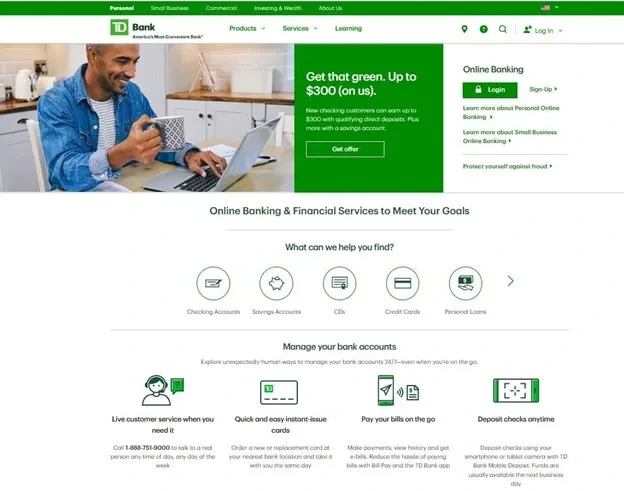
Pro Tip: Ensure that your digital services are accessible to a wide range of users. That includes those with disabilities. This will help maximize inclusivity and reach a broader audience.
Want a full list of trends for social media marketing in 2024? We’ve got you covered! Read more here: 9 Top Social Media Marketing Trends Taking the World By Storm
Key Takeaways
To stay competitive in the financial services industry, it’s critical to keep up with the latest financial services marketing trends. Consumer preferences are constantly evolving. So your marketing and PR strategies should constantly evolve.
As long as you make trust the cornerstone of your new marketing efforts you should see great results. Building and maintaining customer trust is the foundation for success in the financial services industry. And you can do that best through honest and transparent communication.
So, get started by reviewing your current strategies to see where they could use a boost from new trends and ideas.
Not sure how to get started? Feel that your marketing and PR strategy could use a full review? Let us help! Simply book a free consultation and we will see where you could use a boost.

